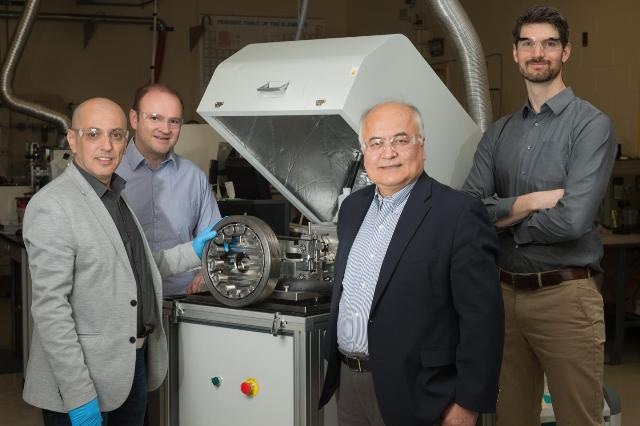May 19 2016
Despite the rigors of scientific analysis and the systematic approaches of the most talented researchers of the world, science still surprises us at times.
 Researchers from Argonne's Surface and Lubrication Interaction, Discovery and Engineering initiative developed a novel "diamond-like" coating that could prove of great benefit when used to coat equipment for wind turbines, like the bearing in this photo. Pictured from left, Levent Eryilmaz, Giovanni Ramirez, Ali Erdemir and Aaron Greco. (Credit- Argonne/Wes Agresta)
Researchers from Argonne's Surface and Lubrication Interaction, Discovery and Engineering initiative developed a novel "diamond-like" coating that could prove of great benefit when used to coat equipment for wind turbines, like the bearing in this photo. Pictured from left, Levent Eryilmaz, Giovanni Ramirez, Ali Erdemir and Aaron Greco. (Credit- Argonne/Wes Agresta)
This was the case when a team of scientists from the U.S. Department of Energy's (DOE) Argonne National Laboratory and the University of Akron found that a specific type of carbon coating, not essentially designed for wind turbines, could be a boon for the wind industry - an unexpected discovery that was highlighted in the Tribology International journal recently.
Due to the exhausting environment within the wind turbine drivetrains, important components like bearings, actuators, and gears tend to fail, suggesting that turbines require maintenance regularly, and this increases the cost of wind energy. Increasing the life of this machinery could reduce the price of wind power greatly, the world’s fastest growing source of energy, making it an even more attractive source of energy.
These drawbacks can be attributed to an occurrence called micropitting, where the recurring sliding and rolling cycles in the bearings and gears of turbines result in cracks on the surface of drivetrain parts. Additional contact exacerbates the cracking as soon as it begins, chipping off the metal and raising the severity of the already present cracks until expensive maintenance is essential or, even worse, when the drivetrain fails.
Enter Argonne's Tribology and Thermal-Mechanics Section and its Surface and Lubrication Interaction, Discovery and Engineering (SLIDE) initiative that examines how materials and lubricants interact and creates new lubrication and coating concepts that lessen friction, and thus micropitting, increasing the life of components over a range of energy technologies.
At times they become a little lucky. This is what happened when SLIDE scientists used this "diamond-like" (few of the carbon-to-carbon bonding in the coating is identical to that of diamonds) coating to wind turbine parts, which was not the proposed use.
We felt that if it was working under other sliding conditions, it might work in wind turbine drivetrains as well. Initially, our expectations were low, as we thought the coating would wear out due to the high stresses inherent in wind turbines, but that didn't happen.
Ali Erdemir, Argonne Distinguished Fellow, SLIDE
The coating, called N3FC, has shown its worth through more than 100 million testing cycles without any substantial micropitting. Erdemir concedes that they have no exact idea of how far it would go, as it has gone beyond the time limit of SLIDE's benchtop micropitting test rig. If the coating behaves similar under real-world conditions, it would produce huge savings in terms of maintenance and prevention of wind turbine failure throughout the nation - almost millions of dollars, said Erdemir. But first, he said, they should understand precisely why it works.
We don't yet understand the exact mechanism. The general belief is that component wear life extension requires a much harder coating, as more hardness reduces wear. But in this case the coating has less hardness than the base steel, so conventional thought doesn't apply.
Ali Erdemir, Argonne Distinguished Fellow, SLIDE
The researchers are now anticipating working with companies and checking how N3FC functions on the field. Until then, they will remain busy trying to understand the mechanism behind this amazing scientific development. "We would love to get to the bottom of this and design even better coatings," said Erdemir.
The team is also analyzing the coating of compressors in sealing applications. It may also be useful in hydrogen and natural gas environments, as a low-friction surface coating.
It appears to have multiple capabilities in terms of performance.
Ali Erdemir, Argonne Distinguished Fellow, SLIDE
Although most of the work was carried out in Argonne's tribology lab, Raman spectroscopy (which utilizes monochromatic light, generally from a laser) was carried out at the lab's Center for Nanoscale Materials, a DOE Office of Science User Facility.